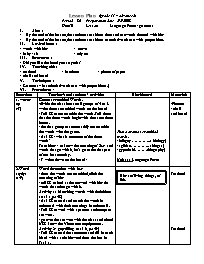Bài soạn môn học Tiếng Anh 11 - Period 86 - Unit10: Lesson: Language Focus - Grammar

I. Aims :
- By the end of the lesson, the students are able to form and use words formed with bio-
- By the end of the lesson, the students are able to use relative clauses with preposition.
II. Lexical items :
- words with bio- - nerve
- baby - sit - rely on
III. Structures :
- Did you like the hotel you stayed at?
IV. Teaching aids:
- textbook - handouts - pieces of paper
- chalk and board
V. Techniques :
- Grammar – based (relative clauses with prepositions.)
VI. Procedures :
Bạn đang xem tài liệu "Bài soạn môn học Tiếng Anh 11 - Period 86 - Unit10: Lesson: Language Focus - Grammar", để tải tài liệu gốc về máy bạn click vào nút DOWNLOAD ở trên
Lesson Plan (grade 11 – advanced) Period : 86 Preparation date : 2/2/2008 Unit10 : Lesson : Language Focus- grammar Aims : By the end of the lesson, the students are able to form and use words formed with bio- By the end of the lesson, the students are able to use relative clauses with preposition. Lexical items : - words with bio- - nerve - baby - sit - rely on Structures : - Did you like the hotel you stayed at? Teaching aids: - textbook - handouts - pieces of paper - chalk and board Techniques : - Grammar – based (relative clauses with prepositions.) Procedures : State/time Teacher’s and students’ activities Blackboard Materials 1. warm-up (4’) Game: scrambled Words. -divide the class into small groups of 4 or 5. -write three scrambled words on the board - Tell SS to unscramble the words. Tell them that the three words begin with the same three letters. - the first group to successfully unscramble the words wins the game. - Ask SS : what is common of the three words? Transition: - to know the meaning of Bio- and words that go with it, let’s go to the first part of our lesson today. - T writes down on the board : These are the scrambled words: - loibgoy ..( biology) - agiblso.. ( biogas) - gyprohabi(biography) Unit 11: Language Focus -Pictures - chalk and board 2.Word stydy: (15’) Word formation with bio- - from the words unscrambled, elicit the meaning of bio- - tell SS to look at the network with bio- for words that often go with it. Activity 1: Matching words with definitions ( task a, p.148) - Ask SS to read and match the words in column A with their meanings in column B. - Tell SS to work with a partner and compare answers. - go over the answers with the class and check if SS know the Vietnamese equipments. Activity 2: gap-filling (task b, p.149) - Tell SS to read the sentences and fill in each blank with a suitable word from the box in Task a. - go around to control and give help if necessary. - call on some students to read their completed sentences and check with the whole class. Bio- : of living things, of life. Textbook Textbook 3. grammar (20’) Relative clauses with prepositions. - write the following pair of sentences on the board - Ask SS which word of phrase is repeated. (expected: the room) - ask about the function of each in the sentences. ( expected: the first phrase is the subject, the second is the object of the preposition in) - Tell SS to combine the pair of sentences using a relative clause. Encourage them to write it in as many ways as possible. - present the grammar point in detail: + Re. pronouns as an object of a preposition in defining relative clauses can follow the preposition: Pre. + whom / Which. In this case only whom or which is possible. It is more usual to move the preposition to the end of the relative clause (but before an expression of time and place if any.) , using who(m), which, or that or omitting the re. pronoun altogether. - do the tasks in the textbook and corrects them. Ex: the room was very small. The meeting was held in the room. Ex: the room in which the meeting was held was very small. Ex: - the room which / that meeting was held in was very small - the room the meeting was held in was very small. - textbook - Chalk and board Textbook 3. Homework (1’) Sentence transformation. Ask SS to rewrite each sentence using the word give: 1. I have to deliver the parcel to the house but I cant’t remember it.(to) à I cann’t .. 2. I had no reply to the question that Nam asked me ( which) à Nam asked . 3. Joe was waiting for the bus and it was late. (for) à the bus . . -Handout
Tài liệu đính kèm:
 p86.doc
p86.doc





